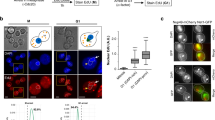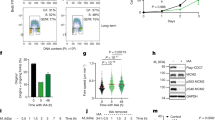Abstract
In the budding yeast, Saccharomyces cerevisiae, division is controlled in response to nutrient limitation1 and in preparation for conjugation2. Cells deprived of an essential nutrient or responding to mating pheromones cease division and become synchronous in the G1 interval, apparently constrained from completing a critical event. This event has been given the operational designation of ‘start’. We have isolated a large number of start mutations which confer on S. cerevisiae cells a conditional inability to complete start3,4 (Fig. 1) presumably because they define genes which must be expressed for the start event to be successfully completed. We have described the isolation on plasmids of one of the start genes, CDC28, by genetic complementation5 and initial characterization of its product6,7. We now describe the DNA sequence of the gene CDC28.
This is a preview of subscription content, access via your institution
Access options
Subscribe to this journal
Receive 51 print issues and online access
$199.00 per year
only $3.90 per issue
Buy this article
- Purchase on Springer Link
- Instant access to full article PDF
Prices may be subject to local taxes which are calculated during checkout
Similar content being viewed by others
References
Johnston, G. C., Pringle, J. R. & Hartwell, L. H. Expl Cell Res. 105, 79–88 (1977).
Bucking-Throm, E., Duntze, W., Hartwell, L. H. & Manney, T. R. Expl Cell Res. 76, 99–110 (1973).
Hartwell, L. H., Culotti, J., Pringle, J. & Reid, B. Science 183, 46–51 (1974).
Reed, S. I. Genetics 95, 561–577 (1980).
Nasmyth, K. A. & Reed, S. I. Proc. natn. Acad. Sci. U.S.A. 77, 2119–2123 (1980).
Reed, S. I., Ferguson, J. & Groppe, J. C. Molec. cell. Biol. 2, 412–425 (1982).
Reed, S. I. Gene 20, 255–265 (1982).
Sanger, F., Nicklen, S. & Coulsen, A. R. Proc. natn. Acad. Sci. U.S.A. 74, 5463–5467 (1977).
Messing, J., Crea, R. & Seeburg, P. A. Nucleic Acids Res. 9, 308–321 (1981).
Berk, A. J. & Sharp, P. A. Cell 12, 721–732 (1977).
Doolittle, R. F. Science 214, 149–159 (1981).
Barker, W. C. & Dayhoff, M. O. Proc. natn. Acad. Sci. U.S.A. 79, 2836–2839 (1982).
Shoji, S. et al. Proc. natn. Acad. Sci. U.S.A. 78, 848–851 (1981).
Van Beveren, C. et al. Nature 289, 258–262 (1981).
Papkoff, J., Nigg, E. A. & Hunter, T. Cell 33, 161–172 (1983).
Duesberg, P. A. Nature 304, 219–223 (1983).
Beach, D., Durkacz, B. & Nurse, P. Nature 300, 706–709 (1982).
Kozak, M. Microbiol. Rev. 47, 1–45 (1983).
Author information
Authors and Affiliations
Rights and permissions
About this article
Cite this article
Lörincz, A., Reed, S. Primary structure homology between the product of yeast cell division control gene CDC28 and vertebrate oncogenes. Nature 307, 183–185 (1984). https://doi.org/10.1038/307183a0
Received:
Accepted:
Issue Date:
DOI: https://doi.org/10.1038/307183a0
This article is cited by
-
The cell cycle and acute kidney injury
Kidney International (2009)
-
CDKA and CDKB kinases from Chlamydomonas reinhardtii are able to complement cdc28 temperature-sensitive mutants of Saccharomyces cerevisiae
Protoplasma (2008)
-
Eukaryotic checkpoints are absent in the cell division cycle ofEntamoeba histolytica
Journal of Biosciences (2002)
-
The plant cell cycle in context
Molecular Biotechnology (1998)
Comments
By submitting a comment you agree to abide by our Terms and Community Guidelines. If you find something abusive or that does not comply with our terms or guidelines please flag it as inappropriate.



